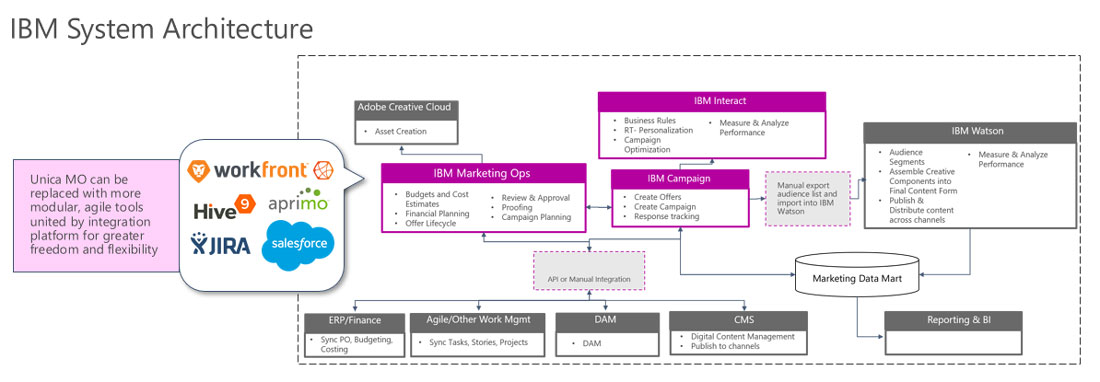In light of the recent HCL announcement, the IBM Unica marketing suite will see new ownership as soon as mid-2019. While the lab and dev teams come as part of the acquisition package, it’s unclear what the impact will be on the Unica Marketing Operations (UMO) module. If you’re an existing UMO customer, you are probably asking yourself the following questions:
- Should I switch from IBM Unica Marketing Operations?
- What information do I need to decide whether to stay with IBM Unica Marketing Operations?
- Is IBM Unica at risk now?
If UMO has made sense for your organization because of its relationship to IBM, then now may be the time to re-assess its fitness to helping you achieve your operational goals. At this point comparing UMO-without-IBM to the several work management and resource management options on the market is worth your while.
What will happen?
We don’t know for sure what’s in store. We do know that HCL’s strategy is to diversify from its core engineering, software, and IT outsourcing model to provide technology solutions in marketing, commerce, and security. We also know that this stated intent doesn’t guarantee the new owner will invest in Marketing Operations. With the future of the UMO/IMO product unclear, and with a user base that’s not leveraging key features, the best course now is to assess its fit in your stack.
Your assessment involves asking yourself important questions about the pros and cons of staying the course vs. moving on. While we don’t have hard-and-fast answers based on your particular situation, this post raises the issues you need to consider.
Implications of the acquisition
The acquisition, or “intellectual-property” partnership as it’s being called, could have major implications for end users:
- Partner continuity. Can you count on the consulting partner ecosystem to migrate to HCL’s partner network? A key benefit of working with third-party consultants is that they often have direct access to the tech company’s dev and support teams and can help you submit tickets and get service faster.
- Transition risk. Are inopportune interruptions to support and communications in store? Anyone who’s been through a technology acquisition knows there are often growing (or shrinking) pains that affect the end user.
- Focus level. With the strategic focus on marketing automation, will the marketing operations module may be pushed farther out of the spotlight? When attention shifts from your solution that often results in less support, fewer updates, and stagnancy.
Determining MO fitness in 2019
Unica MO gained prominence in the early 2000s and has been a good fit for companies who heavily committed to Unica’s leading campaign management solution. Since then, a panoply of campaign management technologies have taken leadership, while new resource management solutions (like UMO) have deployed more modernly architected and user friendly experiences.
That said, if you’ve been with IBM for a long time, chances are you have a considerably customized solution. Therefore, making a decision to move away from Unica MO will require some rigor. In comparison to leading modern solutions in the marketing operations space, specific areas to assess fitness include:
Should I stay or should I go?
To make the decision of whether to stay the course or make a move, consider these major areas of analysis:
SYSTEM CAPABILITIES
-
- Campaign: What does your content and campaign management lifecycle look like? Is it integrated with UMO? IBM-Unica Marketing Op’s primary value proposition is native integration with IBM-Unica Campaign. If you aren’t using UMO to manage the offer lifecycle (in tandem with either a native or integrated DAM system) and share targeting attributes with Campaign, then you’re missing out on a major feature – and paying for it with less-than-optimal user experience. Maximizing value from this functionality is challenging, requiring high levels of technical skill and coordination among teams – even more so if you’ve been using the using the IBM suite for long time. That said, when implemented correctly, teams do benefit from the integrated system in terms of marketing capability (personalization) and speed-to-market. Ask yourself: Are you willing to make the effort?
-
- Finance: Are you using the financial management functionality? Is your team trained and leveraging the module to its fullest extent? As an operations management system, UMO offers complex and rich financial management capabilities, allowing users to compare budget versions and adjust campaign budgets on the fly. The risk, however, is similar to what we described above related to Campaign integration: The financial management module is complex and requires thoughtful implementation and high user skill to see true value. Ask yourself: Would you better off with a simpler, easier-to-use solution with similar capabilities?
-
- Resource Management: Is it easy to find available resources and assign them to your projects with UMO? Compared to point-and-click, automated resource allocation solutions, UMO’s manual, report-driven resource management may not seem as modern. For managing workflows and assigning general process tasks to teams, UMO does a fine job. But for managing a specific person’s utilization down to the day, UMO is less suited for creative services or in-house agency teams in tandem with marketing processes. Finding the right person to complete a task is cumbersome at best, and outside of some out-of-office delegation features, this is not a particularly robust UMO capability compared to other systems on the market. Is settling an option when it comes to using your resources effectively?
[vc_separator type='transparent' position='center' color='' border_style='' thickness='' up='15' down='15']
OTHER CONSIDERATIONS
-
- Connectivity and ease of integration: With 6,829+ marketing applications on the market, is it easy to connect them? Unica MO has always been known for its open API structure and ability to add custom code to a “trigger,” but as more robust, drag-and-drop integration platforms come of age, the time required for custom development work (and the maintenance cost associated with it) is becoming less appealing. Does it make sense to keep a maintenance, support staff on hand to manage the custom APIs and code needed to make UMO work for you?
-
- User experience: Do resource management solutions need to be cumbersome to use? Limited control over a user’s experience means anyone who needs to go in the system – including business partners and execution teams – needs more tech-savvy than they would with more user-friendly solutions. It’s possible that over time, your organization has developed ways to overcome this – again, with custom APIs and web-forms, that you must also maintain with every upgrade or release cycle. Is it worth it, especially when easier options are out there?
-
- Marketing-built solution: Are your marketing’s resource management needs different enough from the whole enterprise that your firm needs a marketing-specific solution? The balance between any operational system is that in order for it to effectively manage resources across teams and drive collaboration, those teams need to agree to use it. Yet specialized teams (Finance, HR, IT as well as Marketing) need tools that can support their line of work. If the work and resource management tools are disconnected, the process will be disconnected too. Switching to an operational system that can be deployed across functions, or that easily unites disparate tools to preserve teams’ unique work styles, can help the entire organization synchronize efforts and truly optimize resources. Isn’t that a scenario to shoot for?
-
- Agile vs. Waterfall: Doesn’t fast and iterative trump any other approach? Agile Marketing is a new way to think about marketing production – leveraging the philosophy and vernacular of software development to create a new approach to tactical deployment that emphasizes testing, learning, and speed-to-market. Unfortunately, UMO doesn’t natively support agile methods or offer any out-of-the-box agile features. Even if your marketing team is comfortable with more traditional waterfall-style project management, it’s likely they need to collaborate with agile IT and technical teams, and so must do so in another, disconnected system. Isn’t it time to employ the nimble processes that help deliver the customer experience you need to compete?
-
- Implementation cycle: How long is too long to wait for benefit? New UMO customers experience (and long-time customers remember) implementation cycles averaging six months to one year. This is due to the complexity and rigor needed to deploy the operational system and undertake the upgrade cycles. Lighter weight solutions can get the job done faster, often having your team up and running in a matter of weeks, not months or years. They can also be upgraded and enhanced over time with less planning and IT support. Is the time it takes and the distractions it makes worth it?

In summary
If Unica MO still meets all your marketing production needs, if you’re leveraging the Campaign integration and other operational modules, and if your users are tech-savvy and experienced enough with the system to navigate, find reports, and manage their work, it may not be worth the effort to switch.
But if you’re looking to create a more flexible and user-friendly martech stack that supports agile, now may be the opportune time to explore new MRM tools.
Thinking about making a change? Complete this “Contact Us” form to receive Zee Jay’s MRM feature comparison between Unica, Aprimo, and Workfront in January 2019.

